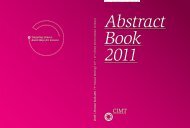Abstract Book 2010 - CIMT Annual Meeting
Abstract Book 2010 - CIMT Annual Meeting
Abstract Book 2010 - CIMT Annual Meeting
Create successful ePaper yourself
Turn your PDF publications into a flip-book with our unique Google optimized e-Paper software.
068 Guthmann | New targets & new leads<br />
Cellular and humoral immune response to N-glycolyl-GM3<br />
elicited by racotumomab, an anti-idiotypic vaccine<br />
Marcelo D Guthmann 1 , Cecilia Venier 1 , Estrella Levy 1 , Mónica A Castro 2 , Gabriela Cinat 2 ,<br />
Roberto Gómez 3 , Ana María Vázquez 4 , Leonardo Fainboim 1<br />
1 Hospital de Clínicas José de San Martín, University of Buenos Aires, Argentina<br />
2 Instituto de Oncología A. Roffo, University of Buenos Aires, Argentina<br />
3 Laboratorio Elea, Buenos Aires, Argentina<br />
4 Center of Molecular Immunology, Havana, Cuba<br />
Gangliosides are a family of sialylated glycolipids<br />
which are normal components of the cell membrane.<br />
They have been found to be important actors in<br />
multiple aspects of cellular interaction with its environment<br />
and with transmembrane signaling. As<br />
such, they are involved in cancer progression and<br />
have become the focus of several immunotherapeutic<br />
approaches. Not all gangliosides are equally<br />
immunogenic. N-acetyl-GM3, the main gangliosides<br />
on the cell surface and the most abundant<br />
ganglioside in normal serum, is one of the most<br />
immunologically tolerated member of the family.<br />
In contrast, N-glycolyl-GM3, is not expressed in<br />
human normal tissues due to a species-specific<br />
genetic mutation that abrogates the biosynthesis of<br />
N-glycolylneuraminic acid (Neu5Gc). Neu5Gc has<br />
been reported, however, in human tumors, and its<br />
presence might be derived from dietary sources<br />
or a yet unknown alternate synthesis pathway. Nglycolyl-GM3<br />
is expressed in melanoma, breast and<br />
lung cancer cells, and is highly immunogenic. As a<br />
result, it has been considered as a target of choice<br />
for immunotherapy.<br />
We investigated with an extended vaccination protocol<br />
the immunogenicity and toxicity profile of racotumomab,<br />
an anti-idiotypic vaccine mimicking<br />
N-glycolyl-GM3. The year-long vaccination scheme<br />
consisted of six bi-weekly intradermal injections<br />
followed by 10 monthly boosters. Nineteen patients<br />
with high risk (stage III) or metastatic breast<br />
cancer were vaccinated with different dose levels<br />
of racotumomab (0.5, 1 and 2 mg). The humoral<br />
and cellular responses to racotumomab and to the<br />
targeted ganglioside were assessed at baseline and<br />
throughout the treatment. Anti-idiotype antibodies<br />
and anti-N-glycolyl-GM3 IgM and IgG antibodies<br />
were determined by ELISA. Serum antibody reactivity<br />
was also tested against P3X63 Ag8 653 murine<br />
myeloma cells and B16 murine melanoma cells.<br />
Frequency of N-glycolyl-GM3—reactive cells was<br />
calculated by IFNγ ELISPOT. For that purpose, cryopreserved<br />
PBMC and autologous DC were incubated<br />
with N-glycolyl-GM3—containing liposomes.<br />
Equivalent amounts of unloaded liposomes were<br />
added to control wells. After a 24-h culture, cells in<br />
each well were resuspended and transferred to triplicate<br />
wells in an IFNγ-precoated ELISPOT plate.<br />
Subsequent steps for detection of IFNγ-secreting<br />
cells followed standard ELISPOT procedures. Patients<br />
with no response at baseline and with a posttreatment<br />
two-fold increase in the number of spots<br />
in N-glycolyl-GM3 stimulated wells (versus unstimulated<br />
wells) were considered as responsive.<br />
All patients showed a strong antibody response to<br />
N-glycolyl GM3. In addition, ganglioside-specific<br />
IFNγ responses were recorded in 5 of 13 evaluable<br />
patients.<br />
113



